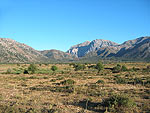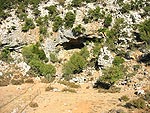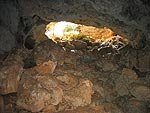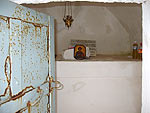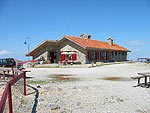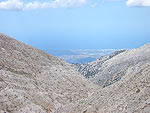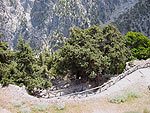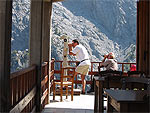| The Omalos plain is the result of several different geological processes, which have caused subsidence of the area, as it occurs from the sketch in Fasoulas' book about Crete's geology. Eventually eroded materials have slithered or been washed down from the surrounding mountains and created the fertile soil. | ||||
|
2.
Rocks of phyllite and quartz |
||||
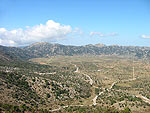 |
Even if the plain seems quite flat at first sight, the difference in height is in fact 200 m between the lowest point (1.047 m) at the entrance from Chania and Xyloskalo (1.236 m) on the way down to the Samaria gorge. There are three exits from the plain: The road to Chania on the northern edge, the road to Agia Eirini on the south-western and Xyloskalo on the south-eastern edge. | |||
|
|
||||
| The plain is 25 km2 and is mainly used for the grazing of large flocks of sheep and goats and for a little agriculture (animal feed and potatoes). On Omalos there is only one settlement named after the plain. It is situated in the northern part and consists of some hotels, restaurants, a dairy and some private houses. Otherwise there are only a few houses scattered on the plain. | ||||
|
|
||||
| Just as you enter the plain from Chania, there is a huge cavern to the right. The cavern is not visible from the road, but is situated just left of the big hollow in the rock. It is called Tzanis' Cave or Chonos (= funnel). Tzanis, a resistances fighter in the early years of the Turkish period, lived in the cave. | ||||
|
|
||||
| On closer examination the cavern turned out to be enormous with 3 km long galleries, reaching to a depth of 600 m. The melt water is lead through the cavern down to the lowlands and further on to the sea. | ||||
|
|
||||
| A little after the Tzanis' cave you see Chatzimichalis Giannaris' house on the top of a small hill on the left side of the road. It is a typical example of the so-called tower-houses (pyrgospita), where the residents could barricade themselves in case they were attacked. | ||||
|
|
||||
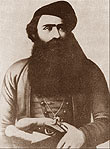 |
Chatzimichalis Giannaris was born in Lakki in 1831 and died in 1916. He thus lived during one of the most turbulent periods in Cretan history, and all his life he participated in different rebellions against the Turks. Even though he was captured several times, he always managed to escape. After an exceptionally difficult escape from the Firkas castle in Chania in 1860, he built the Agios Panteleimon church next to his house. In 1877 he returned from Odessa, where, for some time, he was expatriated. In 1889 he became a member of the conservative party the Karavanades (the Wise Ones). A that time there were two parties, the conservative party and a more liberal party, whose members were called Xypolytoi (the Bare-footed Ones). In 1912 Giannaris became a member of the government of the Kritiki Politeia (Period of Cretan Independence). | |||
|
|
||||
|
Behind the house there is a small building with Giannaris' tomb. |
||||
|
|
||||
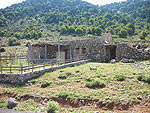 |
It is also worth taking a look at the old farmers' houses, zevgospita, where the farmers lived during the summer. Some of the houses, which are all situated at the edge of the plain, have been renovated lately and are now used as holiday cottages. | |||
|
|
||||
| In the eastern angle of the plain a dirt road leads up to the Kallergis refuge, where hikers can seek shelter or stay for the night. | ||||
|
|
||||
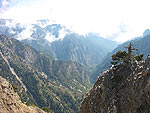 |
From this place there is an impressive view to the Samaria gorge, the Omalos plain, and to the north you can catch a glimpse of Chania and the Theodoros island. | |||
|
|
||||
| Far to the east is the entrance to the Samaria gorge, which is called Xyloskalo (wooden stairway) because of the wooden stairs that the shepherds built in order to make the entrance to the gorge easier. | ||||
|
|
||||
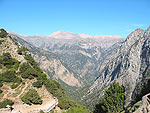 |
Above the Xyloskalo there is a restaurant, from which there is a fantastic view of the gorge with Pachnes and some other of the highest peaks of the Lefka Ori in the distance. | |||
|
|
||||
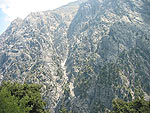 |
To the south rises the grey mountain Gingilos, where - with a little luck and some patience - you maybe can to see the famous Cretan wildgoat, the kri-kri. | |||
|
|
||||
| Even if Gingilos seems to be very close, you have to use the large binoculars on the terrace. | ||||
|
|
||||
| From
the pass on the south-western edge of the plain, where there are a few small houses, the road leads to the Selino district, where
among other
villages you find those of Agia Eirini and Sougia.
|
||||
 |
After a couple of hundred metres from the plain you come to a small Agios Theodoros church. | |||
|
|
||||
| Winter-photos from Omalos | ||||
| Spring-photos from Omalos | ||||

